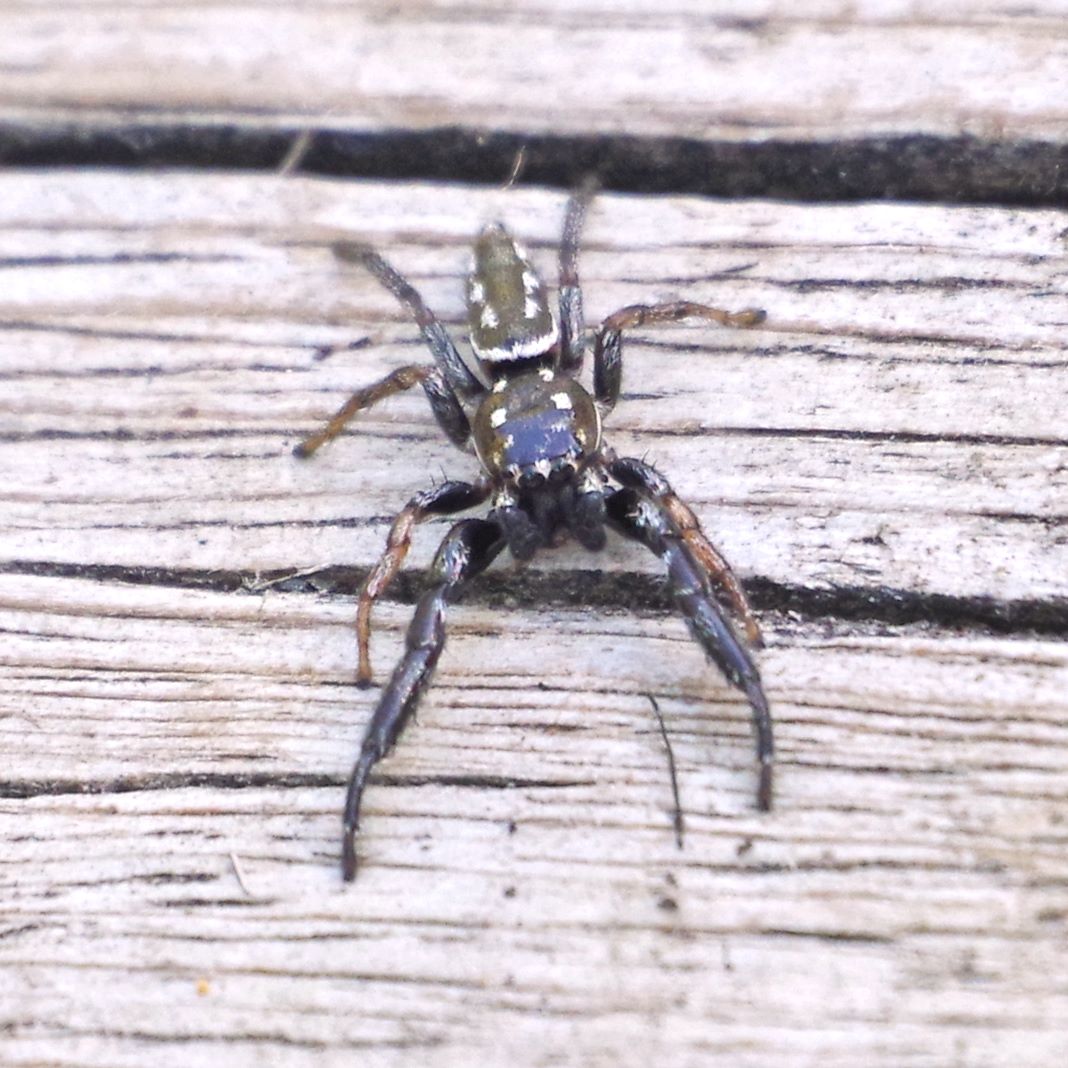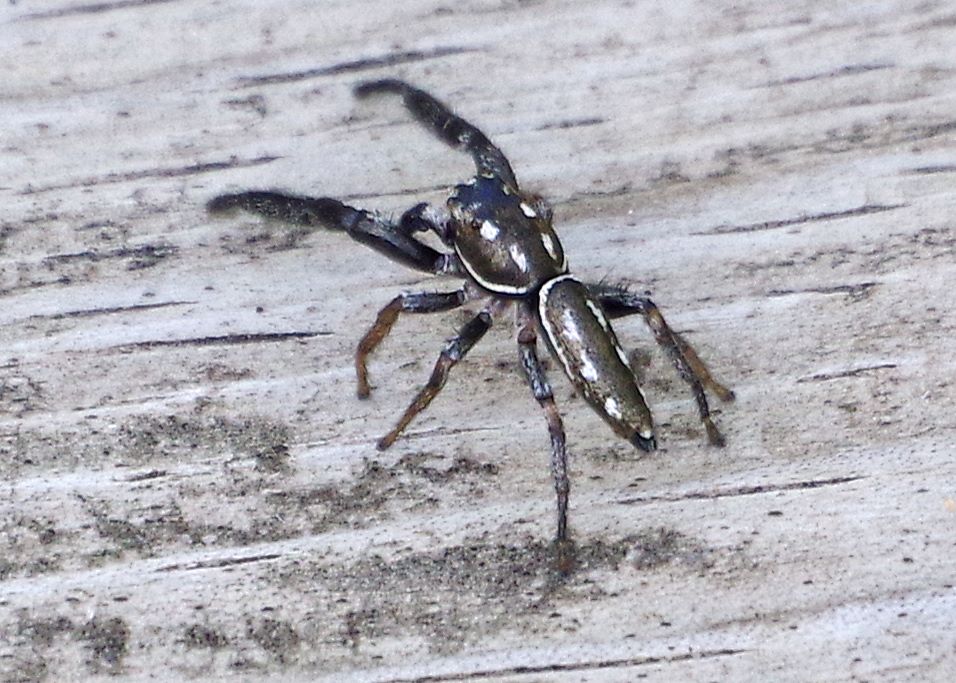
by Kate Redmond
Bug o’the Week Beautiful Jumper
Howdy, BugFans,
The BugLady was on a pier at Riveredge Nature Center when this spectacular jumping spider climbed out from between the planks.
Like the old joke about bacon being the gateway meat for vegetarians, jumping spiders seem to be the gateway spider for arachnophobes. Many are fuzzy (well, the spiders are – the BugLady can’t vouch for the arachnophobes), and because the front part of their cephalothorax (the combined head and thorax) is flat, four of their eyes face forward, https://bugguide.net/node/view/1940583/bgimage, and they look at you in a very human way. Plus, they are curious and they have attitude. If the BugLady had not already given her heart to crab spiders, these anthropomorphic little beauties would be at the top of her spider list.
The jumping spiders, family Salticidae (the Latin word “saltare” means “to leap, dance or hop”), comprise our largest spider family, with over 6,000 species worldwide and 315 species in North America. They are a very diverse family, found everywhere except the very far North and the very far South. Almost all are carnivores, but there are a few that have added nectar to their menus, and one species (with the fabulous scientific name of Bagheera kiplingi) that is primarily vegetarian.
They don’t make trap webs like orbweavers, but they do spin little shelters from which they peruse their landscapes and in which they shelter during cloudy or rainy weather. When likely prey comes along, they stalk it, orient their bodies, and then launch themselves at it (after attaching a “dragline” that controls both their jump and their landing and that provides a lifeline if they overshoot their mark).
And how do jumping spiders jump? Not with long, muscular legs, like grasshoppers, but via their hydraulic system. According to Noel Kirkpatrick, writing for the “Treehugger” blog, when they want to jump, “the spiders cause an extreme change in hemolymph pressure (the spider equivalent of blood pressure) by contracting the muscles in the upper region of their bodies. This forces blood to their legs, and causes their legs to extend rapidly. This quick and sudden extension of their legs is what propels them in the direction they’re aiming.” Some species may travel two or three body lengths, but others may jump 30 times their length.
Jumping spiders have good hearing (though they “hear” not with ears but with sensory hairs that pick up sound waves and send messages to the spider’s brain), and they have spectacular vision. Their eye arrangement – four facing front and four facing up – is characteristic only of the jumping spiders. Those two, big eyes in the center of their face (AMEs – anterior median eyes) have moveable retinas and supply resolution, color, and telephoto vision. The ALEs (anterior lateral eyes) on each side are not as sharp, but are far enough apart to allow some depth perception, and research suggests that they tell the AMEs where to look.

The row of four, fixed “posterior” eyes across the top of their head allow the spider to see light, movement, and wide angles. Their visual range is nearly 360 degrees, compared to our 210 degrees. According to a Minnesota Department of Natural Resources website, jumping spiders “are able to identify prey, predators, and mates from up to 30 cm (1 ft.) away.”
In addition, aided by their great vision, jumping spiders can recognize landmarks and find their way home, can learn from their hunting experiences and improve their technique as they age, and can distinguish between animate and inanimate objects (which is pretty sophisticated). Scientists don’t know how they do that.
And through the magic of TikTok, jumping spiders are having a moment.
The BEAUTIFUL JUMPER (Marpissa formosa) isn’t particularly warm and fuzzy-looking – or very big – but it’s a striking spider. It’s found, spottily, east of the Great Plains and around the Great Lakes (it’s a species of Special Concern in Minnesota), and it likes wetlands. It’s one of those species that has stayed under the radar, so not much is known about it, but it’s presumed to follow the general jumping spider game plan.
Where many species of jumping spiders are chunky, Beautiful Jumpers are long and slim. They are dimorphic – males (https://bugguide.net/node/view/887835/bgimage) and femaleshttps://bugguide.net/node/view/1867778/bgimage are different colors. Females are about 3/8” long, and males are slightly smaller. Like all jumping spiders, they move quickly.
They eat spiders (including other jumping spiders) and small insects, and they may steal trapped insects from spider webs. The Minnesota Department of Natural Resources says that “Having spotted a potential quarry, a jumping spider will slowly stalk the prey until it is within jumping distance. Then it lifts its front legs and pounces.”
Like other jumping spiders, male Beautiful Jumpers dance and thrum for their ladies, displaying their color patterns and making species-specific clicks and buzzes and taps that travel through the substrate and are picked up by her sensory hairs. Females deposit their eggs into a silk “tent” spun by the male, and then guard the eggs until they hatch and for a short time afterward, until the spiderlings make their first molt and disperse. “Adolescent” spiders overwinter in silk shelters in logs or rock crevices and mature the following year.
And, yes, you can find jumping spider stuffed toys online, but caveat emptor – the BugLady found one cute, little, felt jumping spider with cute little antennae.
Kate Redmond, The BugLady
Bug of the Week archives:
http://uwm.edu/field-station/category/bug-of-the-week/
